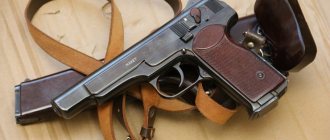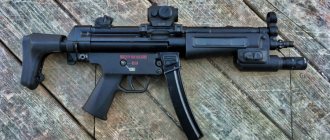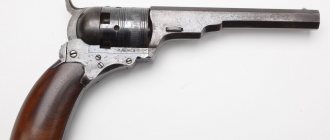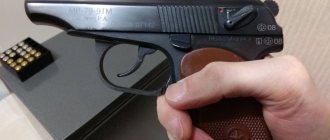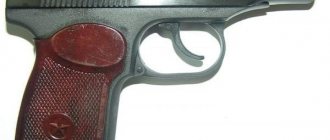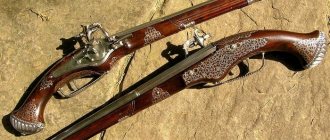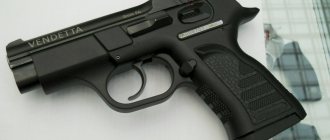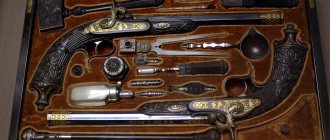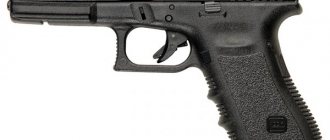Is it possible to preserve your name for centuries? To accomplish a feat so that grateful descendants erect a monument? Or end up on the pages of history? But monuments are being destroyed, and history is being rewritten. So is there really no such possibility? It turns out there are, even several. The first is to become a hero of folklore, such as Ilya Muromets, Ivan Susanin or Chapaev. The second possibility is for your proper name to become a household name, such as cardan (named in honor of the inventor Gerolamo Cardano) or Kalash (in honor of Mikhail Timofeevich Kalashnikov). So, the American inventor Samuel Colt was able to take advantage of these two opportunities. His name found its way into an American folk proverb, which, loosely translated, reads as follows: “God created people different, but Colonel Colt evened out the odds.” In addition, a revolver system is named after him, and most of the names of this pistol are written with a small letter and without quotation marks. But before we talk about the invention of the American gunsmith, let's conduct a short educational program about the calibers and systems of hand-held melee weapons - pistols.
What is caliber
Currently, there are several standards for designating weapon calibers, so there are often situations when they try to compare 45 caliber and 16 (and for some reason the 45 turns out to be smaller) or 5.45 and 3 lines (here 5.45 turns out to be smaller). In most European countries, including Russia, caliber is measured in the metric system. The measurement is made in millimeters along the diameter of the trunk. Accordingly, for rifled weapons the diameter of the cartridge will be slightly larger (by the depth of the rifling). In the USA, Great Britain and some other countries, mainly members of the British Commonwealth, caliber is measured in fractions of an inch, in the USA in hundredths, and in the United Kingdom in thousandths. Therefore, the US 45 caliber is equal to the British 450 and the Russian 11.43. Smooth-bore hunting rifles stand apart in this row. Their caliber refers to the number of round-shaped bullets that can be cast from one pound of lead. Accordingly, the smaller the barrel diameter, the more bullets you will get. There is also another standard for measuring caliber, which TV hardly uses at present. These are lines. One line contains one tenth of an inch, respectively, for the Mosin rifle model 1893, the famous three-line, caliber 3x2.54 = 7.62 millimeters. Now let's move on to the design of hand-held melee weapons.
Glock 21
With a polymer frame and modern design, this Austrian-made gun is one of the most effective .45 caliber pistols on the market. The Glock 21 is a slightly larger copy of the Glock 17. It is 210 grams heavier than the 17th model and five millimeters longer. The magazine capacity of the 21st is smaller - 13 rounds.
Photo: wikipedia/Jmm1713
The use of polymers in the design means that a loaded 13-round Glock 21 weighs approximately 227 grams less than a seven-round M1911 with a full magazine. The Glock is easier to disassemble for cleaning than the M1911.
Systems
There are two main schemes: pistol and revolver. Both of them have their advantages and disadvantages. The main advantage of modern pistols is the speed and ease of reloading, the ability to fire automatically (for some models, for example, the Stechkin pistol). The advantage of revolvers is their high reliability, there is no need to send a cartridge into the barrel after reloading and there is no automatic extraction of cartridges, which in some cases is good from the point of view of secrecy, for example when working with special units.
The most powerful small arms. Part 2. UMP45 submachine gun chambered for .45 ACP
The UMP (Universal Machine Pistole) submachine gun produced by the famous German arms company Heckler & Koch might not have been included in the rating of the most powerful small arms if it had not been produced for cartridges of various calibers. The most powerful version of this universal submachine gun, the UMP45, is chambered for the .45 ACP cartridge (11.43x23 millimeters). This model of firearm combines a high stopping power of a bullet, moderate recoil and high accuracy of fire. Unlike the Desert Eagle pistol, the UMP submachine gun, even when modified for the fairly powerful .45 ACP cartridge, is used by special forces and army units of some countries, and its younger brothers chambered for the 9x19 mm Parabellum or .40S&W (10x22 mm) cartridge are even more common wide.
Heckler & Koch engineers created the versatile UMP submachine gun in the 1990s as an addition to the popular and world-famous HK MP5 submachine gun family. The design of the new model was simplified, but at the same time, more modern materials were used in the UMP design. The company initially planned to offer its model on the police weapons market in the United States, so it chose .40S&W and .45 ACP ammunition, popular in America, for it; a submachine gun version chambered for the 9x19 mm Parabellum cartridge appeared later.
Currently, there are three varieties of the UMP submachine gun: the most powerful UMP45, chambered for the .45 ACP pistol cartridge, the UMP40, respectively, chambered for the .40S&W cartridge, and the UMP9, chambered for the 9×19 mm Parabellum cartridge. Despite the difference in weapon caliber, all three submachine guns have the same design; the external difference between the three models lies only in the shape of the magazine. For submachine guns in large calibers, the magazine is straight; for the 9x19 mm Parabellum cartridge, it is curved. All three versions can, if desired, be quite easily transformed into each other by replacing the barrel, bolt and magazine; during development, the Germans implemented a modular design of the submachine gun.
In addition to the three listed versions, there is also one civilian version on the market - this is the USC (Universal Self-loading Carbine) - a universal self-loading carbine. It was designed specifically for further export to the United States and met all American standards for civilian weapons. The carbine differs from its combat counterparts in the shape of the butt, a longer barrel, a magazine limit of 10 rounds (at the time of development in the United States there were restrictions on the capacity of magazines for civilian weapons), while USC magazines are not compatible with combat versions, and the carbine also does not have a pistol grip fire control and there is no ability to conduct automatic fire. This civilian version can be used for sporting purposes or for self-defense. Sales of the USC carbine were discontinued in 2013.
It is worth noting that the designers of Heckler & Koch took almost six months to create a submachine gun capable of firing bursts of cartridges of such a large caliber as .45APC. Initially, they tested the same semi-blowback design that was implemented in their MP5 submachine gun and was traditional for the company. However, this scheme could not withstand long-term use of the weapon, as a result of which the new submachine gun failed after only 5 thousand shots. As a result, the engineers of the German company switched to a blowback design.
The German HK UMP45 submachine gun is a small weapon built according to a blowback design. The principle of automatic operation is used - the recoil of a free bolt; fire from a submachine gun is fired from a closed bolt. The trigger mechanism is trigger. The weapon has a two-way safety switch for fire modes, as well as a bolt delay, which ensures that the bolt stops in the open position after all the cartridges in the magazine are used up. The following fire modes are available to the shooter: single shots, automatic fire, and burst shooting with a cutoff of 2 or 3 shots can also be optionally available. Since the UMP submachine gun was originally created for firing large-caliber cartridges, and also due to the difficulties in feeding .45 ACP cartridges compared to conventional 9x19 mm, the technical rate of fire was artificially limited to 600 rounds per minute, which makes this submachine gun one of the slowest on the international market.
The UMP submachine gun is distinguished by its low weight, the UMP9 is immediately 0.75 kg lighter than the similar MP5 A3 submachine gun, this is due to the widespread use of modern impact-resistant plastic in the UMP design, which not only made it possible to significantly reduce the weight of the weapon, but also ensured its resistance to corrosion. The bolt box of the submachine gun is made of plastic; a trigger box made of plastic with a magazine receiver and a pistol grip is also attached to it from below. Impact-resistant plastic has good resistance to damage and stress, which allows you to freely use the weapon in field conditions. The weight of the UMP9 submachine gun without a magazine is only 2.35 kg, the weight of the UMP45 submachine gun without a magazine is 2.47 kg.
The UMP45 pistol grip has a rounded shape and small notches on the cheeks and butt plate; at its base there is a small protrusion for the shooter’s little finger for more comfortable holding in the hand. The trigger guard is large, allowing you to shoot the submachine gun with gloves on or hold the weapon with your left thumb through the guard (like the Beretta 93R). The magazine latch is straight, like in a Kalashnikov assault rifle, it is made of metal and has deep corrugation, the stroke is short and clear, and the magazine is not removed from the weapon, but falls out like in pistols.
The fire mode switch is double-sided, reversible (the lever is directed towards the butt of the submachine gun), it has three positions: - uppermost position - locking the firing pin and trigger, while the trigger is still pressed; - middle position - fire with single shots; - lowest position - automatic fire, switching on occurs with a slight click.
The submachine gun has the ability to replace the fully automatic fire mode with firing in short bursts of 2 or 3 rounds. To make such a replacement, you need to change the self-cocking lever or install another trigger mechanism module on the weapon. This module is fixed on the weapon using two “fangs”, which are located in front of the magazine receiver, and a long bolt connecting it to the receiver and located behind the fire mode translator.
The UMP45 uses a stock that folds to the right (some people find this option more convenient than the MP5); it can be locked in the folded position. The folding buttstock of the skeletal type with two cutouts of the UMP45 submachine gun, unlike the receiver, is reinforced and has an aluminum frame, which significantly increases its strength. However, taking into account the fact that the butt fixing elements are made of plastic, you should hit something with it with some caution. With the stock unfolded, the length of the UMP45 is 695 mm, with the stock folded – 455 mm.
On the top of the UMP45 receiver there are sighting devices, which use the usual rear sight and front sight. The rear sight is reliably protected on both sides by the projections of the receiver. This is important when operating in tight spaces and urban areas, where the weapon may accidentally hit an obstacle. The rear sight is also placed in a protective ring. A Picatinny rail can be installed between the sighting devices on top of the receiver, which allows the shooter to install various optical or collimator sights. A total of four Picatinny rails can be mounted on a submachine gun - on the bolt box on the top, on the right, on the left and on the bottom of the body. The ability to install a vertical front handle on the UMP can significantly help the shooter when conducting automatic fire from a weapon.
The barrel of the submachine gun is devoid of any compensators in its muzzle, but at the same time it has a mount for a silent and flameless firing device. The greatest efficiency is achieved when using such a device with subsonic cartridges. The standard barrel length of all three models of the UMP submachine gun is 200 mm; the USC civilian carbine had a barrel length of 400 mm.
Together with the submachine gun, straight box magazines could be used for .45APC and .40S&W cartridges and forward curved magazines for 9x19 mm Parabellum cartridges. The capacity of magazines for .40S&W and 9x19 mm cartridges is 30 rounds, the capacity of a magazine for .45APC cartridge is 25 rounds. Like the receiver, the submachine gun's magazines are made of plastic. On their sides there are special slots covered with transparent plastic. These slots are used for easy control of ammunition consumption.
Comparison of 9x19mm and .45APC cartridges
In general, it can be noted that all UMP submachine guns are excellent for combat in urban environments or in buildings, including in cramped spaces. The weapon is lightweight and small in size, and also provides the shooter with ample opportunities for upgrades and installation of various tactical equipment. The modularity of the weapon and the ability to change calibers should also not be discounted. The UMP45 variant is a very powerful firearm, especially in the submachine gun class. The .45ACP bullet (11.43x23 millimeters) has a very strong stopping effect (albeit with little penetration), but now imagine that a whole line of such bullets is flying at the target. The version of the submachine gun chambered for this cartridge, according to Wikipedia, is used by the special forces of Lithuania and Georgia, and the UMP45 is also used by the special forces of Malaysia, the Philippines and Egypt.
Sources: https://army-news.ru/2012/11/pistolet-pulemyot-ump-45-ot-kompanii-hecklerkoch https://www.armoury-online.ru/articles/smg/de/hk-ump https://modernfirearms.net/ru/pistolety-pulemety/germanija-pistolety-pulemety/hk-ump Materials from open sources
Revolver - Colt 45 caliber
In 1872, the armory presented its model of a revolver chambered for a unitary pistol cartridge. This year was not chosen by chance, since it was then that the patent for a revolving drum with through chambers, previously owned by a competitor, expired. The following year, 1873, a new revolver model was presented, which was adopted by the US Army. Over 20 years, the American armed forces purchased about 37,000 copies of these weapons. The army revolver had a 45 caliber, the civilian revolver - 44. For many 60 years, production of the army version was discontinued, but in the early 50s, mainly thanks to the US film industry and the popularity of westerns, the demand for the Colt-1873 model grew so much that in 1956 their production was resumed in 2009 and continues with minor interruptions to this day.
Springfield Armory XD45 Mod 2 Service Model
The HS Produkt HS2000 pistol, developed in Croatia, attracted the attention of the American arms company Springfield Armory. In the American interpretation, the weapon received the designation (X-treme Duty). The idea to produce this pistol under license turned out to be so successful that within several years the XD model became one of the most popular in the US civilian weapons market.
Photo: springfield-armory.com
The pistol is available in several calibers: 9 mm, .40 Smith & Wesson and .45 ACP. In the American version, much attention is paid to the ease of holding and individual adjustment of the pistol to its owner.
A large notch on the handle, occupying a large area, allows you to hold the weapon stably during high-speed shooting. The barrel of the pistol is made with special care, thanks to which the weapon has the highest shooting accuracy in its class.
The XD45 Mod 2's double-stack magazine holds 13 rounds while maintaining a comfortable grip. By the way, the owner himself can customize the handle to suit his hand using three interchangeable elements. Source
Colt ammunition
In 1905, the world's most popular pistol ammunition, the 45 caliber, appeared. The cartridge is called 45 ACP, it was developed by the Frankford Arsenal. This ammunition quickly became a success due to the very effective stopping effect of the bullet. It was for this cartridge that such well-known weapons as the Colt M1911 pistol and the Thompson assault rifle were designed. Although this ammunition has a number of disadvantages (due to the low initial speed and large weight of the bullet, its flight trajectory is far from flat), its popularity has not fallen to this day. Moreover, new types of bullets were developed for this cartridge, for example, expansive with controlled opening, which “unfolds” when penetrating to the optimal depth in the victim’s body. So these legendary models will delight weapon fans for a long time.
Ed Brown Executive Carry
This pistol is a custom Colt Commander, which, in turn, is based on the M1911. It was originally intended to be worn by officers, so it was smaller in size, but the Colt Commander lost the army competition. But the pistol became popular in the US civilian arms market, becoming a good alternative for those who wanted a military M1911, but were not satisfied with the size of the weapon.
Photo: edbrown.com
The Executive Carry is a variant of the Commander 1911, characterized by precise fitment, high quality and finishing of materials. Made of stainless steel, the gun has a matte finish and its sides are smoothed so as not to cling to clothing.
Version No. 2
0
Version No. 2 looks more serious, and is advocated by Shirokorad and other (very numerous) supporters on the forums. According to this version, supposedly after the revolution, a large amount of armor-piercing ammunition for the aforementioned 47-mm Hotchkiss naval gun accumulated in military warehouses. Okay, there was such a gun. Yes, at that time it was completely outdated, and yes, its shells at sea were theoretically completely useless, so they decided to transfer them to land and use them as anti-tank/infantry support weapons. There weren't very many tanks at that time. Okay, there was such a gun. Yes, at that time it was completely outdated, and yes, its shells at sea were theoretically completely useless, so they decided to transfer them to land and use them as anti-tank/infantry support weapons. There weren't very many tanks at that time. We need to unload the shell. That is, remove it from the sleeve. Then remove the fuse. Yes, just in case. And then you can tighten the projectile into the cartridge and grind the belt. Without a real prospect of getting caught in the explosion of this shell. Next, reinsert the projectile into the cartridge case, restore the seal again, and yes, you can shoot. I immediately have a question: wouldn’t it have been easier to just make a 47-mm cannon and not engage in perversions? Now experts will begin to say that the Hotchkiss gun’s grenade flew at a speed of 700 m/s, the 19-K’s speed was already 760 m/s, and the M1932’s was 820 m/s. And the unfortunate belts could be torn off. I agree, initial projectile velocities have increased. And it was quite possible to rip off the belts. However, there is a nuance here that spoils everything. Namely, a complete lack of data. “There are a lot of shells in warehouses” - how many pieces? Nobody says the number. Yes, in principle, it is unrealistic to name it, because the Russian-Japanese, World War I, Civil War plus the eternal Russian mess.
0
The fact that 47 mm is useless became clear back in the Russo-Japanese War. It was not for nothing that hundreds of Hotchkiss guns were removed from ships, installed on at least some semblance of machine tools and sent to the front line in order to somehow compensate for the shortage of battalion and regimental guns. And since an armor-piercing shell was completely useless for infantry in those years, it is not surprising that these shells were simply lying around in warehouses. It's logical, it's undeniable, it's normal. Another question is how many are in grams... This is a complete mystery, but I think that there were quite a few of them there. If the tsar’s reserves were enough for half of the Great Patriotic War (76.2 mm), then 47-mm “goods” could have been in excess. And here a dual feeling arises. Well, if there are mountains of shells right there, take them and shoot - I return to the question of whether it would have been easier to make a barrel for shells. Simply, at Obukhovsky they deployed not such calibers. Plus (very significant) it would be possible “if something happens” to intercept shells from the allies. During the First World War, both the British and the Americans supplied us with 76.2-mm shells, not exactly to the fullest extent, but they supplied us. But if there are not so many shells, then it is quite possible to decide on such an adventure as regrinding a shell. What are they lying there? Well, let them be useful, such shells can easily be used as combat training, why not? The benefits are huge, the savings are huge, training costs are reduced, let the artillerymen hit with this antiquity for training purposes... But I repeat, it’s very, very doubtful that it’s millions. I found a figure that on January 1, 1901, the Navy Department had 963 47-mm Hotchkiss guns. From this we conclude how many shells for a thousand guns could be in the warehouses. And since we are talking about the fact that there were frankly few guns, it follows that there were hardly millions of shells lying around for them. A couple hundred thousand at most. We are talking about the movements of the 30s of the last century, when the First World War, the Civil War, and the intervention had already died down. And they ate their shells. So it turns out that the mosaic is not quite coming together.
M1911
From 1911 to 1985, the Colt 45 caliber was in service with the United States. In the technical documentation it is listed as M1911.
Due to the high stopping power of the bullet, this semi-automatic rifle was recognized as the best model of weapon for self-defense. The Colt M1911 was produced until 1982. During this time period, the pistol was modernized several times. Despite the fact that the M1911 was retired from service by the US Army in 1985, many private owners still use it today. From 1911 to 1982 The United States gun industry produced three million units of this model. In addition, the M1911 was widely used by British, Soviet, Norwegian and French soldiers. The M1911 was also in service in Nicaragua and El Salvador. Estonia and Haiti have become those states where the 45-caliber Colt is used by the armies today.
About the characteristics
- 45 ACP is a type of pistol cartridge.
- Manufactured in the United States.
- The ammunition was created in 1904 and produced since 1905.
- The total length is 3.24 cm.
- The projectile weighs 15.16 g.
- The length of the sleeve is 22.81 mm, the diameter of its neck is 1.2 cm, the base is 12.09 mm, the flange is 12.19 mm.
- The ammunition is provided with a powder charge weighing from 0.34 to 0.37 g.
- A bullet fired from a barrel has an initial speed of no more than 271 m/s.
- During firing, an energy of 544 J is generated.
MP 80 13T
In the line of various “trauma” weapons available on Russian arms counters, the non-combat rifle unit, which is listed in the technical documentation as MP 80 13T, is in great demand. The basis for this model was the legendary Makarov pistol. MP 80 13T is a 45 caliber “trauma”. Shooting is carried out with 45 Rubber cartridges. This shooting model, as many owners are convinced, is an excellent alternative to the 9-mm Makarych. Since the MP 80 13T uses ammunition with an increased caliber, Russian designers had to reduce the magazine capacity from 8 to 6 rounds. The ammunition is loaded with a 13-mm rubber bullet. During the shot, as the manufacturer assures, an energy of 90 J is generated. In fact, judging by numerous consumer reviews, this figure is slightly lower and varies from 70 to 80 J.
Unlike other “traumas” that use a smaller caliber, when firing from the MP 80 13T, due to the increased diameter of the projectile and the area of its contact, through holes are not formed. When hitting a target, 45 Rubber bullets leave only deep dents. For self-defense, this cartridge is considered the best option, since it will save the gun owner from problems with the law.
